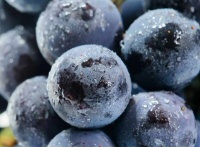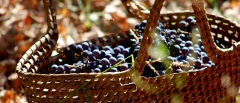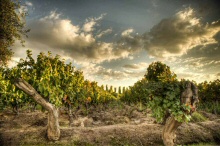|
 Non-traditional varietal wines are kind of "in" these days…as you've probably noticed. Shelves are stocked with not just Cabernet Sauvignon, Merlot, Pinot Noir, or red blends, but with varietals many people are not so familiar with. This includes varietals such as Mourvedre, Tempranillo, Cabernet Franc, Grenache,and…Malbec. Non-traditional varietal wines are kind of "in" these days…as you've probably noticed. Shelves are stocked with not just Cabernet Sauvignon, Merlot, Pinot Noir, or red blends, but with varietals many people are not so familiar with. This includes varietals such as Mourvedre, Tempranillo, Cabernet Franc, Grenache,and…Malbec.
In its homeland of France, one would never see Malbec as a varietal wine. Sacrebleu! Quelle horreur of a thought! But here in California (including Monterey County) and Argentina, Malbec varietal wines are more than proving themselves. In fact, whereas just a few years ago Malbec was a lesser known varietal, it is quickly growing in popularity and now stands amongst its Bordeaux brothers of Cabernet Sauvignon and Merlot.
 Malbec's fruit is thin-skinned, robust in tannins, colored inky dark, sun-loving, and fragile to grow…quite a combination in the viticultural world. Wines produced from Malbec are dark and rich with boldly purple hues. Malbec wines typically have intense aromas of dark berries, cherries, and plums. Malbec's fruit is thin-skinned, robust in tannins, colored inky dark, sun-loving, and fragile to grow…quite a combination in the viticultural world. Wines produced from Malbec are dark and rich with boldly purple hues. Malbec wines typically have intense aromas of dark berries, cherries, and plums.
As for the grape's origins, a popularly held belief is that the Malbec grape originated in the northern Burgundy region of France and that it was originally named Côt. However, the grape found its traditional home southwest of Burgundy in the Bordeaux region, where it is commonly blended primarily with famed Bordeaux red varietals Cabernet Sauvignon and Merlot, and with lesser-known Cabernet Franc, Petit Verdot, or Carmenère.
 The year 1956 was fateful for the Malbec grape as it was the year that France suffered from a particularly nasty growing season laced with killer frost that decimated 75% of the notoriously frost-sensitive Malbec crop…75%! This proved to be detrimental to Malbec's sustained popularity in Bordeaux's vineyards; however, in the Cahors region, slightly southeast of Bordeaux, the grape was replanted with a fury and it continues to be the dominant varietal of the region. In fact, Cahors is the only AOC (roughly our equivalent of AVA) requiring Malbec in its red wines−70% minimum. Cahors' Malbecs are often blended with Merlot or Tannat in order to round out the region's infamously robust wines. The year 1956 was fateful for the Malbec grape as it was the year that France suffered from a particularly nasty growing season laced with killer frost that decimated 75% of the notoriously frost-sensitive Malbec crop…75%! This proved to be detrimental to Malbec's sustained popularity in Bordeaux's vineyards; however, in the Cahors region, slightly southeast of Bordeaux, the grape was replanted with a fury and it continues to be the dominant varietal of the region. In fact, Cahors is the only AOC (roughly our equivalent of AVA) requiring Malbec in its red wines−70% minimum. Cahors' Malbecs are often blended with Merlot or Tannat in order to round out the region's infamously robust wines.
Malbec continues to be grown and blended into succulent Bordeaux blends, however less so as in decades past. But Malbec was not content to rest in Europe and like a curious traveler the grape made its way across the Atlantic and landed in both North and South American vineyards. Argentina has arguably become Malbec's truest home (no disrespect to la France!). The grape literally thrives there and it's quite possible that the grape found its favorite terroir in Argentina. While Malbec has lost fame and acreage in France in the last fifty years, it has experienced the opposite in Argentina, where it is the most widely-planted red grape varietal and has become something of a national grape.
Closer to home, Malbec is gaining in popularity in California's wine growing regions, Monterey included. Since 1995, the acreage of planted Malbec grapes throughout the state has increased by an estimated 800%!
 The Malbec grape remains largely used as a blending grape. It is globally popular as an addition to Bordeaux-style blends with its color, body, and depth; but the grape has seen a resurgence in recent years for its use as a single-varietal wine and continues to catch the attention of wine-makers and wine-drinkers alike. For instance, our showcased Malbec from Marin's Vineyard is sure to awaken your palate. It also proves that Southern Monterey County presents the proper terroir to pull it off (which is not actually the most surprising, as we've known some of our best wineries have been sourcing other outstanding Bordeaux reds from these AVAs.) The Malbec grape remains largely used as a blending grape. It is globally popular as an addition to Bordeaux-style blends with its color, body, and depth; but the grape has seen a resurgence in recent years for its use as a single-varietal wine and continues to catch the attention of wine-makers and wine-drinkers alike. For instance, our showcased Malbec from Marin's Vineyard is sure to awaken your palate. It also proves that Southern Monterey County presents the proper terroir to pull it off (which is not actually the most surprising, as we've known some of our best wineries have been sourcing other outstanding Bordeaux reds from these AVAs.)
Enjoying a nice glass of Malbec on its own may not be the preference for some, as it can be overwhelming to tender palates. If so, hold off until you have a hearty meal in front of you to complement your bold glass of Malbec. The French are renowned for their intrinsic ability to pair wine with an appropriate corresponding dish; the Argentines have their own noble traditions with regards to their "nationalized" grape. Order a steak in Buenos Aires and a glass of red wine, and it will assuredly be a glass of dark Malbec that is poured for you. Whether you choose to pair it with food, or enjoy it on it's own, we hope you enjoy this Monterey County Malbec!
|